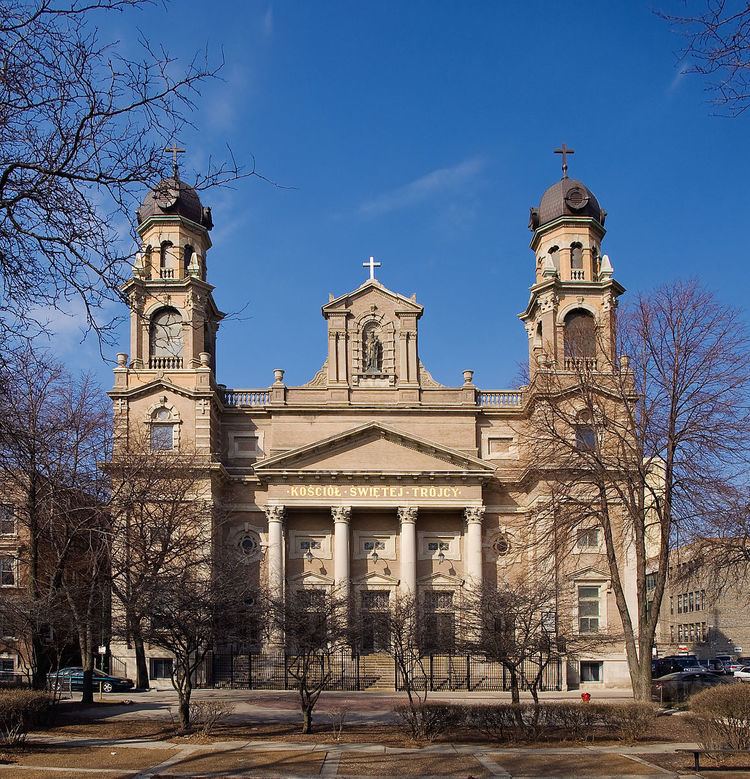 | ||
The Polish Cathedral architectural style is a North American genre of Catholic church architecture found throughout the Great Lakes and Middle Atlantic regions as well as in parts of New England. These monumentally grand churches are not necessarily cathedrals, defined as seats of bishops or of their dioceses.
Contents
Polish Cathedral churches generally have large amounts of ornamentation in the exterior and interior, comparable only to the more famous Churrigueresque or Spanish Baroque style. The decorations used reflect the tastes of the Polish immigrants to these regions in both the symbols and statuary of saints prominently displayed throughout. Additionally there is a heavy proclivity towards ornamentation drawn from the Renaissance and Baroque periods as well as modeling designs after famous churches in Poland. The claim of different 'architectural styles' of Europe ascribed to these churches is misleading, as most of them are already labeled by art historians as examples of Eclecticism and Historicism, characterized by the various Architectural Revivals found in styles of the late 19th and early 20th centuries. These churches exhibit a mixture of architectural traits from numerous past eras characteristic of Europe and the Americas.
A unique synthesis
Skerrett says Polish churches surpassed other immigrants’ churches in size. Their style promoted the immigrants' vision of Polish identity.
Kantowicz writes in The Archdiocese of Chicago: A Journey of Faith: "The preference of the Polish League for Renaissance and Baroque forms seems more clear cut. The glory days of the Polish Commonwealth came in the sixteenth and seventeenth centuries when it formed the largest state in Europe… The architectural style of Chicago's Polish churches in Chicago reflect this, particularly the magnificent edifices of Worthmann and Steinbach built along Milwaukee Avenue on the Northwest Side, reflected the renaissance glory of Polish Catholicism".
Peter Williams in his book Houses of God: Region, Religion, and Architecture in the United States on p. 179 writes,"[I]n Detroit and Chicago especially, a distinctive genre of church building emerged among Polish communities, the "Polish Cathedral." Where most Catholic churches were built in grander or humbler variations and Gothic and Romanesque themes popular across the country, the ambitious prelates in the Great Lakes Polonias often chose to make monumental statements in the Renaissance style of their mother country. The scale of these structures was often enormous, both in the great size of these parishes and the episcopal ambitions of their clerical leaders… Still visible from the freeways, many of these "cathedrals" such as St. Stanislaus Kostka in Chicago now serve African-American or Latino constituencies while others have been closed by their Archbishops as no longer economically viable.
The churches are major tourist attractions in Chicago, with tours devoted exclusively to them. In May 1980 the Chicago Architecture Foundation's ArchiCenter held an exhibit on these treasures titled Chicago's Polish Churches.
These ornate temples were largely built by the working poor in these regions in the era spanning the period from the end of the American Civil War until the end of World War II.
Criticism by other religious groups
These stylistically exaggerated churches were criticized by many of Chicago's Protestant elites as "ostentatious" in comparison with the "plainer" style in vogue for Protestant houses of worship. Catholic Church authorities such as John Lancaster Spalding, the first Bishop of Peoria, responded by comparing the churches financed by the immigrants to the pyramids of Egypt built by slaves.
The need for identity was evident in the unique architecture of the Polish Cathedral Style. It was often associated with the religious order of the Congregation of the Resurrection, in addition to the architectural stylings of the Renaissance and Baroque periods. Both in scale and scope, these edifices were attempts to contradict the marginal status in which the Polish immigrants found themselves. As a stateless people whose culture was systematically attacked in its homeland during the years of partition, they also had a low position on the economic ladder in the turn of the century industrial centers to which they had immigrated. The construction of these churches greatly influenced the development of neighborhoods that surrounded them. World views brought by the Polish immigrants from the Old World, as well as their creative adaptation into the New World, shaped the landscape of the rapidly growing industrial regions to which they came.
